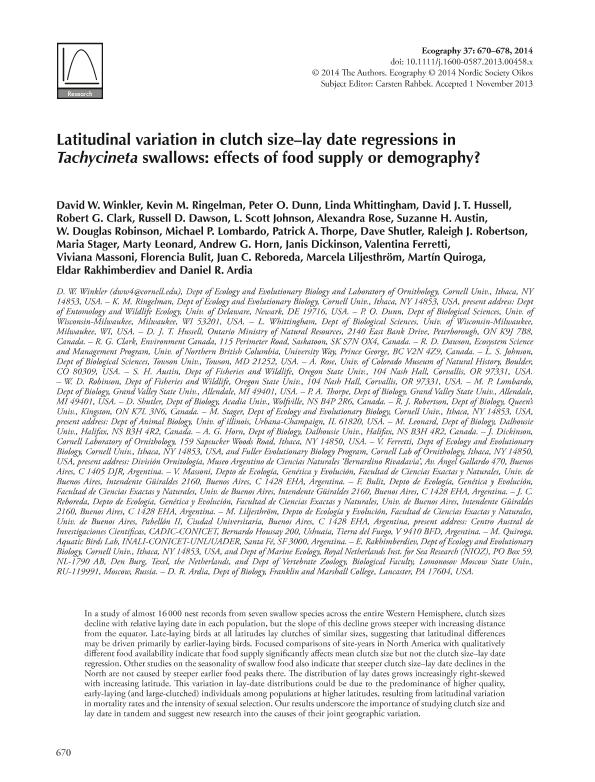Artículo
Latitudinal variation in clutch size-lay date regressions in Tachycineta swallows: Effects of food supply or demography?
Winkler, David W.; Ringelman, Kevin M.; Dunn, Peter O.; Whittingham, Linda; Hussell, David J. T.; Clark, Robert G.; Dawson, Russell D.; Johnson, L. Scott; Rose, Alexandra; Austin, Suzanne H.; Robinson, W. Douglas; Lombardo, Michael P.; Thorpe, Patrick A.; Shutler, Dave; Robertson, Raleigh J.; Stager, Maria; Leonard, Marty; Horn, Andrew G.; Dickinson, Janis; Ferretti, Valentina ; Massoni, Viviana; Bulit, Florencia; Reboreda, Juan Carlos
; Massoni, Viviana; Bulit, Florencia; Reboreda, Juan Carlos ; Liljesthrom, Marcela
; Liljesthrom, Marcela ; Quiroga, Martin Anibal
; Quiroga, Martin Anibal ; Rakhimberdiev, Eldar; Ardia, Daniel R.
; Rakhimberdiev, Eldar; Ardia, Daniel R.
 ; Massoni, Viviana; Bulit, Florencia; Reboreda, Juan Carlos
; Massoni, Viviana; Bulit, Florencia; Reboreda, Juan Carlos ; Liljesthrom, Marcela
; Liljesthrom, Marcela ; Quiroga, Martin Anibal
; Quiroga, Martin Anibal ; Rakhimberdiev, Eldar; Ardia, Daniel R.
; Rakhimberdiev, Eldar; Ardia, Daniel R.
Fecha de publicación:
03/2014
Editorial:
Wiley Blackwell Publishing, Inc
Revista:
Ecography
ISSN:
0906-7590
Idioma:
Inglés
Tipo de recurso:
Artículo publicado
Clasificación temática:
Resumen
In a study of almost 16 000 nest records from seven swallow species across the entire Western Hemisphere, clutch sizes decline with relative laying date in each population, but the slope of this decline grows steeper with increasing distance from the equator. Late-laying birds at all latitudes lay clutches of similar sizes, suggesting that latitudinal differences may be driven primarily by earlier-laying birds. Focused comparisons of site-years in North America with qualitatively different food availability indicate that food supply significantly affects mean clutch size but not the clutch size-lay date regression. Other studies on the seasonality of swallow food also indicate that steeper clutch size-lay date declines in the North are not caused by steeper earlier food peaks there. The distribution of lay dates grows increasingly right-skewed with increasing latitude. This variation in lay-date distributions could be due to the predominance of higher quality, early-laying (and large-clutched) individuals among populations at higher latitudes, resulting from latitudinal variation in mortality rates and the intensity of sexual selection. Our results underscore the importance of studying clutch size and lay date in tandem and suggest new research into the causes of their joint geographic variation.
Palabras clave:
lay date
,
life history traits
,
geographic variation
,
Swallows
Archivos asociados
Licencia
Identificadores
Colecciones
Articulos(ICIVET-LITORAL)
Articulos de INST. DE CIENCIAS VETERINARIAS DEL LITORAL
Articulos de INST. DE CIENCIAS VETERINARIAS DEL LITORAL
Articulos(IEGEBA)
Articulos de INSTITUTO DE ECOLOGIA, GENETICA Y EVOLUCION DE BS. AS
Articulos de INSTITUTO DE ECOLOGIA, GENETICA Y EVOLUCION DE BS. AS
Citación
Winkler, David W.; Ringelman, Kevin M.; Dunn, Peter O.; Whittingham, Linda; Hussell, David J. T.; et al.; Latitudinal variation in clutch size-lay date regressions in Tachycineta swallows: Effects of food supply or demography?; Wiley Blackwell Publishing, Inc; Ecography; 37; 7; 3-2014; 670-678
Compartir
Altmétricas



